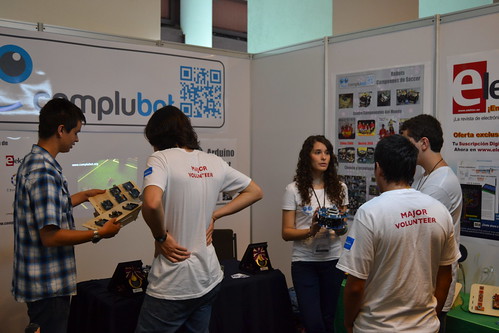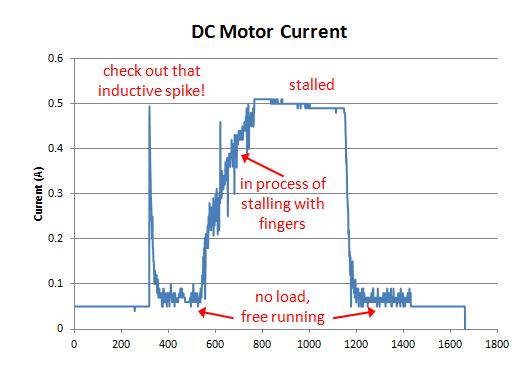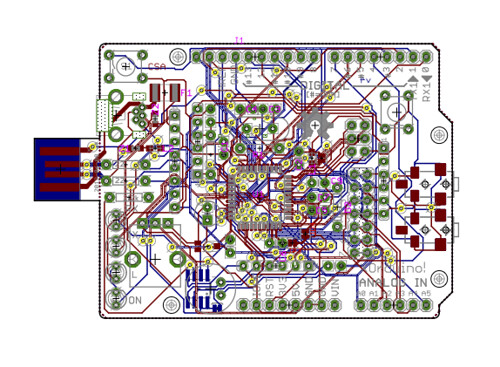ARDUINO AT ROBOCUP MEXICO 2012
– June 21st, 2012
You might have heard the news via other media, but we are building a robot. For almost two years now we have been collaborating with the Complubot Educational Robotics Association from Madrid, Spain. We have gone through several iterations of prototypes, we have been 3D printing wheels, we have looked into color screens, screws, sound speakers …

(c) 2012 Complubot, Nerea revising the robots for RC-Mexico 2012
Things are coming along and we are close to the release our first robot. The experience of building this is being amazing and I am sure there will be more bots following this first one.
When we started this process, I knew a lot about digital electronics, but little about robotics. During the last two years I burnt some transistor chips, and made some motors move, I read the books, talked to the people, traveled back and forth to Complubot’s headquarters at a school in Alcala de Henares to check ideas, revise the hardware, and talk about software.
Six months ago, we -Ivan, Nerea, Eduardo and me- passed over the eagle files to Arduino’s hardware guru for him to evaluate the best way to manufacture the robot. We tested battery charging systems, DC-DC converters to improve the response from the motors, tried better display technologies, and now we have our alpha robot running. The project we have been calling “Lottie Lemon” is about to become The Arduino Robot.

(c) 2012 Compubot, Ivan (left) and Nerea talking to some of the RCJ volunteers before opening to the public
We are presenting The Arduino Robot at the RoboCup Mexico 2012 at Complubot’s booth. Nerea, Ivan, and Eduardo are representing Arduino, showing the robots, running a workshop for the attendants to the RCJ event, demoing all the official Arduino boards, and reporting back for the rest of us.
Follow their adventures (in Spanish) at their blog, and come back to ours for more information soon.
SPACE EXPERIMENTS FOR EVERYONE: THE ARDUSAT PROJECT
– June 19th, 2012

ArduSat, which stands for “Arduino satellite”, is a recently kickstarted projectthat aims at developing an open platform usable to emulate space scientists:
Once launched, the ArduSat will be the first open platform allowing the general public to design and run their own space-based applications, games and experiments, steer the onboard cameras to take pictures on-demand, and even broadcast personalized messages back to Earth.
ArduSat will be equipped with several sensors (such as cameras, gyros, accelerometers, GPS and more) packed inside a small cube (the side will be approximately 10 cm long) that can be accessed through a set of Arduinos.
Once in orbit, the ArduSat will be accessible from the ground to flash the required firmware for the experiments and for getting back all the collected information. People interested in performing space experiments will have access to a ground replica of ArduSat explotable to test and debug their code before the actual deployment.
The project is very ambitious, and it is expected that such an open accessible space platform will have a considerable impact on how simple space experiments will be carried out in the forthcoming years, in the case of fundraising success.
You may find the Kickstarter page of the project here.
[Via: Hack A Day and Kickstarter]
AN IBM SELECTRIC II WISHES TO BE A TELETYPE
– June 15th, 2012

In his blog, Marc from Robot Dialogs presents a very nice hack involving a IBM Selectric II typewriter: by means of an Arduino board and several solenoids, the typewriter can be successfully connected to a computer to emulate a vintage teletype.
The complete story can be found here, together with several videos about its development.
[Via: Hack A Day]
QUICK TUTORIAL: CURRENT SENSING FOR DC MOTORS
– June 15th, 2012
On her blog, Dustyn Roberts presents her own experience on current sensing for controlling DC electric motors with an Arduino board and an Arduino Motor Shield. This shield, based on a L298 H-bridge, provides two current sensing pins to the user, which can be used to measure the instantaneous current absorpion by each H-bridge. After some trials, Dustyn managed to have a quite clear picture of the absorption behavior of the DC motor:

Sample code and updates can be found on Dustyn’s blog.
[Via: Dustyn's blog]
XORDUINO: AN ARDUINO-COMPATIBLE BOARD FOR THE OLPC XO LAPTOP
– June 15th, 2012

Dr. Scott Ananian, from the One Laptop Per Child (OLPC) project, conceived an Arduino Leonardo-compatible board especially designed for the OLPC XO laptop, with the goal to cut down its price as much as possible, to foster its adoption even in developing countries. From Scott’s blog:
The board uses mostly through-hole parts, with one exception, and there are only 20 required components for the basic Arduino functionality, costing about $5 (from digikey, quantity 100). It is reasonable for local labor or even older kids to assemble by hand.
The board, named XOrduino, is open hardware (schematics and pcb files can be found on github), and can be directly plugged into the XO’s USB ports, which allowed Scott to save the money required for the USB connector. Moreover, its design has been inspired by other open hardware projects, such as SparkFun’s ATmega32U4 breakout board and SparkFun’s Scratch Sensor Board-compatible PicoBoard.
Scott designed also a second board, which is even cheaper than the first one, called XO Stick:
It’s very exciting to see how open technologies, such as open hardware and open source software, contribute to the way education and creativity can take place around the world, especially regarding their promotion in developing countries.
ARDUINO BARCAMP ZARAGOZA 2012
– June 15th, 2012
Arduteka en colaboración con Cooking Hacks y Milla Digital del ayuntamiento de Zaragoza han preparado un evento con capacidad para más de 400 personas en uno de los edificios más emblemáticos de la ciudad, el Antiguo Seminario Metropolitano de Zaragoza transformando en una moderna Ciudad Administrativa Municipal y que amablemente han cedido para organizar el evento.
Desde charlas sobre arte interactivo con Arduino como interface, pasando por talleres sobre impresión 3D hasta demostración de integración de Arduino conAsterisk será solo una parte de lo que vamos a poder disfrutar, ya que estarán habilitados diferentes Stands como el de Parrot, en que podremos probar el nuevo Ar-Drone 2.0, el de Cooking Hacks que nos amenizarán con micro talleres Arduino e incluso el de nuestros amigos de Ultra-Lab que seguro hará las delicias de los asistentes.
Por si esto fuera poco.. Contaremos con la presencia y colaboración de David Cuartielles, el cual nos ofrecerá una charla sobre los últimos productos Arduinoque se está aconteciendo…
Te lo vas a perder??
Via | Arduteka
TASTY TWEETS
– June 13th, 2012
Tasty Tweets is a data visualization experiment that allows users to explore twitter trends through taste with a press of a button. The installation has been developed by Kostantinos Frantzis, Ruben van der Vleuten and Kat Zorina during the Data Visualization course 2012 at Copenhagen Institute of Interaction Design,
Using the Twitter APIs, the project collects tweets containing mentions of fruits such as blueberry, pineapple, apple and carrot and creates a smoothie. The layering of the juices results in a visual representation of the proportions of flavors mentioned – a graph in a glass.
Since twitter trends are changing very quickly, each smoothie has a unique palette of flavors.

The Twitter APIs is used to gather the tweets while Processing is used to analyze and process the data and Arduino controls the flow of liquids into the glass with solenoids.
More info here.
VARIATIONS II OF VARIATIONS II
– June 12th, 2012
Variations II of Variations II is a kinetic sculpture inspired by John Cage’s Variations series.
Cage’s Variations II is a graphical composition that generates musical events using measurements of distance between dots and lines on a piece of paper.
The instructions for the piece determine the behavior of rotating panels and images synchronized to be projected onto the sculpture. Motors drive the rotation of the panels, and are used as a sound source for the audio portion of this piece.

The artist Jay Kim has used C/C++, Arduino, MaxMSP/Jitter and some stepper motor to create his sculpture.
Watch the video.
Via:[Synthopia]
WISP: A WIFI MODULE FOR THE INTERNET-OF-THINGS
– June 12th, 2012

embdSocial™ is an Internet-of-Things (IoT) platform usable to provide communication support to smart objects and devices. embdSocial™ is based onWISP™, an electronic module that can be connected to any microcontroller-equipped device (such as an Arduino board, by means of ad-hoc shield) to exploit several communication services:
Each WISP™ allows real-time bi-directional communication through our secure, globally accessible API. In addition to merely providing internet connectivity, embdSocial™ provides one interface and architecture that simplifies common tasks through the use of plug-ins:
- Tweeting/receiving @messages
- Updating Facebook statuses
- Sending/receiving emails
- Sending/receiving SMS text messages
- Manipulating files in your Dropbox
Each WISP™ is equipped with a 802.11 network interface (with support to WEP, WPA and WPA2 protocols) which allows the device to be easily connected with the embdSocial™’s servers; moreover, its configuration is completely web-based.

More information can be found on the embdSocial™ homepage, together with a couple of videos presenting its capabilities.
[Via: HackADay and embdSocial]
@JARROSELAPLANTE SOCIAL BOTANICAL PROJECT
– June 12th, 2012
@JarroseLaPlante is an installation created by Félicien Goguey and Thomas Meghe.
This plant has a twitter account, you can water it by direct tweets. Since a single tweet can’t save her, she needs twitter friends to grow up!
A Processing application listens to new tweets via Twitter APIs. A servo motor is bringing water to the plant while sensor checks its the humidity rate (if it’s too low the plant tweets in order to alert her followers).
If you follow the plant’s account, she can send you private messages.

Go here to visit the plant. And do not forget to water it!












0 comentarios:
Publicar un comentario